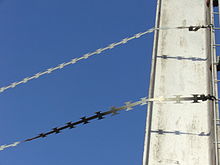This article has multiple issues. Please help improve it or discuss these issues on the talk page. (Learn how and when to remove these messages)
|

Barbed tape or razor wire is a mesh of metal strips with sharp edges whose purpose is to prevent trespassing by humans. The term "razor wire", through long usage, has generally been used to describe barbed tape products. Razor wire is much sharper than the standard barbed wire; it is named after its appearance but is not razor sharp. The points are very sharp and made to rip and snag clothing and flesh.
The multiple blades of a razor-wire fence are designed to inflict serious cuts on anyone attempting to climb through or over it and therefore also has a strong psychological deterrent effect. Razor wire is used in many security applications because, although it can be circumvented relatively quickly by humans with tools, penetrating a razor-wire barrier without tools is very slow and typically injurious, often thwarting such attempts or giving security forces more time to respond.
Use

The first use of barbed wire for warfare was in 1898 during the Spanish American War, thirty-one years after the first patents were issued in 1867. One of the most notable examples during the Spanish American War is the defense provided by the Moron-Jucardo Trocha. The trocha (or trench) stretched for fifty miles between the cities of Moron and Jucardo. Within this trench, and in addition to fallen trees, barbed wire was used. The barbed wire was arranged in a cat’s cradle formation that for every 12 yards of barbed fence built, 420 yards of barbed wire was strung (or 35 yards of wire per yard of fence).
Later versions of this type of barbed wire were manufactured by Germany during the First World War. The reason for this was a wartime shortage of wire to make conventional barbed wire. Therefore, flat wire with triangular cutting edges began to be punched out of steel strips ("band barbed wire"). A welcome side effect was that a comparable length of barbed wire of this new type could be produced in less time. These precursors to NATO wire did not yet have an inner wire for stabilization, were therefore easy to cut with tin snips, and were also not as robust as normal barbed wire. However, they withstood the wire cutters used at the time to cut normal barbed wire, as was common at the front.
An article in a 1918 issue of The Hardware Trade Journal tells the story under the headline: "This Cruel War’s Abuse of Our Old Friend ‘Bob Wire.'" After telling a little about Glidden and his invention, the article goes on as follows: "Quite naturally some animals enclosed by Glidden’s fencing gashed themselves on the barbs. Just as naturally, men and boys tried to climb over or under those fences and had their clothes and flesh torn...These wounds upon man and beast and the suddenness with which Glidden’s barbs halted all living things came to the attention of military men, and the barbed wire entanglement of which we now read almost every day in the war news was born...And it may be said right here that soldiers who have been halted by wire entanglements while making a charge say the devil never invented anything nastier."
Starting in the late 1960s, barbed tape was typically found in prisons and secure mental hospitals, where the increased breaching time for a poorly equipped potential escapee was a definite advantage. Until the development of reinforced barbed tape in the early 1980s (and especially after the September 11 attacks), it was rarely used for military purposes or genuine high security facilities because, with the correct tools, it was easier to breach than ordinary barbed wire. Since then, some military forces have replaced barbed wire with barbed tape for many applications, mainly because it is slightly lighter for the same effective coverage, and it takes up very little space compared to barbed wire or reinforced barbed tape when stored on drums.
More recently, barbed tape has been used in more commercial and residential security applications. This is often primarily a visual deterrent since a well-prepared burglar can breach barbed wire and barbed tape barriers in similar amounts of time, using simple techniques such as cutting the wire or throwing a piece of carpet over its strands.
Due to its dangerous nature, razor wire/barbed tape and similar fencing/barrier materials are prohibited in some locales. Norway prohibits any barbed wire except in combination with other fencing, in order to protect domesticated animals from exposure.
Construction

Razor wire has a central strand of high tensile strength wire, and a steel tape punched into a shape with barbs. The steel tape is then cold-crimped tightly to the wire everywhere except for the barbs. Flat barbed tape is very similar, but has no central reinforcement wire. The process of combining the two is called roll forming.
Types
| This section possibly contains original research. Please improve it by verifying the claims made and adding inline citations. Statements consisting only of original research should be removed. (March 2024) (Learn how and when to remove this message) |
| This section does not cite any sources. Please help improve this section by adding citations to reliable sources. Unsourced material may be challenged and removed. Find sources: "Razor wire" – news · newspapers · books · scholar · JSTOR (March 2024) (Learn how and when to remove this message) |
Like barbed wire, razor wire is available as either straight wire, spiral (helical) coils, concertina (clipped) coils, flat wrapped panels or welded mesh panels. Unlike barbed wire, which usually is available only as plain steel or galvanized, barbed tape razor wire is also manufactured in stainless steel to reduce corrosion from rusting. The core wire can be galvanized and the tape stainless, although fully stainless barbed tape is used for permanent installations in harsh climatic environments or under water.
Barbed tape is also characterized by the shape of the barbs. Although there are no formal definitions, typically short barb barbed tape has barbs from 10–12 millimetres (0.4–0.5 in), medium barb tape has barbs 20–22 millimetres (0.8–0.9 in), and long barb tape has barbs 60–66 millimetres (2.4–2.6 in).
According to the structure
- Helical type: Helical type razor wire is the most simple pattern. There are no concertina attachments and each spiral loop is left. It shows a natural spiral freely.
- Concertina type: It is the most widely used type in the security defense applications. The adjacent loops of helical coils are attached by clips at specified points on the circumference. It shows an accordion-like configuration condition.
- Blade type: The razor wire are produced in straight lines and cut into a certain length to be welded onto the galvanized or powder coated frame. It can be used individually as a security barrier.
- Flat type: A popular razor wire type with flat and smooth configuration (like Olympic rings). According to different technology, it can be clipped or the welded type.
- Welded type: The razor wire tape are welded into panels, then the panels are connected by clips or tie wires to form a continuous razor wire fence.
- Flattened type: A transformation of single coil concertina razor wire. The concertina wire is flattened to form the flat-type razor wire.
According to the coil type
- Single coil: Commonly seen and widely used type, which is available in both helical and concertina types.
- Double coil: A complex razor wire type to supply higher security grade. A smaller diameter coil is placed inside of the larger diameter coil. It is also available in both helical and concertina types.
Common specifications of razor wire
| Specification | Wire dia. (mm) |
Barb (mm) | |||
|---|---|---|---|---|---|
| Thickness | Length | Width | Spacing | ||
| BTO-10 | 2.5±0.1 | 0.50±0.05 | 10±1 | 13±1 | 26±1 |
| BTO-12 | 2.5±0.1 | 0.50±0.05 | 12±1 | 15±1 | 26±1 |
| BTO-18 | 2.5±0.1 | 0.50±0.05 | 18±1 | 15±1 | 33±1 |
| BTO-22 | 2.5±0.1 | 0.50±0.05 | 22±1 | 15±1 | 34±1 |
| BTO-28 | 2.5 | 0.50±0.05 | 28 | 15 | 45±1 |
| BTO-30 | 2.5 | 0.50±0.05 | 30 | 18 | 45±1 |
| CBT-60 | 2.5±0.1 | 0.60±0.05 | 60±2 | 32±1 | 100±2 |
| CBT-65 | 2.5±0.1 | 0.60±0.05 | 65±2 | 21±1 | 100±2 |
-
Short barb razor wire with central reinforcement
-
Medium barb razor wire
-
Long barb razor wire on a fence. At the bottom there is some barbed wire.
See also
References
- Carlson, Benjamin John (2013-02-01). "Barbed Wire Museum" (PDF). core.ac.uk. Retrieved 2023-06-07.
- "Barbed Wire War – How One Farmer's Innovation Changed The Battlefield". MilitaryHistoryNow.com. 2014-01-08. Retrieved 2023-06-07.
- "Barbed Wire". National Museum of the United States Air Force™. Retrieved 2023-06-07.
- "World War I Centenary: 100 Legacies of the Great War". The Wall Street Journal. Retrieved 2023-06-07.
- Vučković, History Nerds, Aleksa. World War 1: The Sacrifice of a Generation. History Nerds.
{{cite book}}: CS1 maint: multiple names: authors list (link) - Moore, Sam (2018-04-12). "Barbed wire's history entangled in war". Farm and Dairy. Retrieved 2023-06-07.
- Zaretsky, Robert (September 27, 2015). "The tangled history of barbed wire". BostonGlobe.com. Retrieved 2023-06-07.
- § 15 in Lov om dyrevelferd (Animal welfare law). Accessed November 5th, 2018, at https://lovdata.no/dokument/NL/lov/2009-06-19-97/KAPITTEL_1#%C2%A715
External links
 Media related to Barbed tapes at Wikimedia Commons
Media related to Barbed tapes at Wikimedia Commons